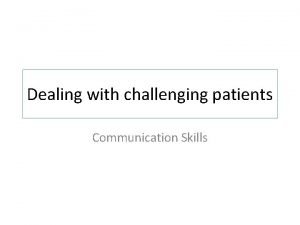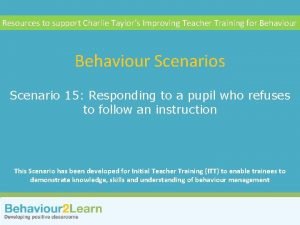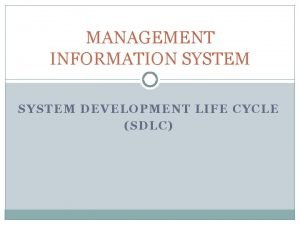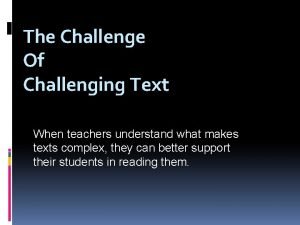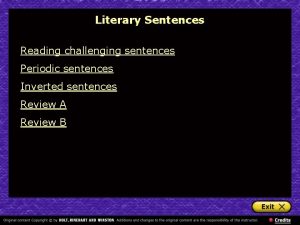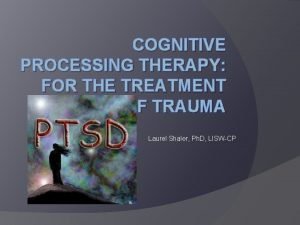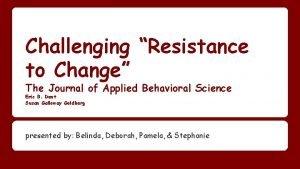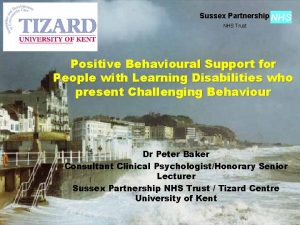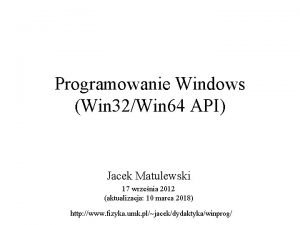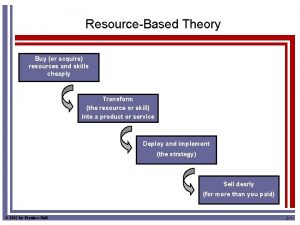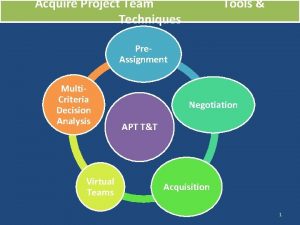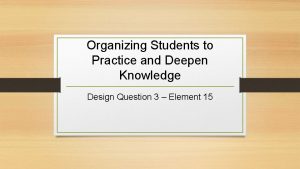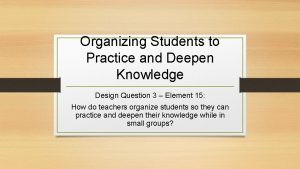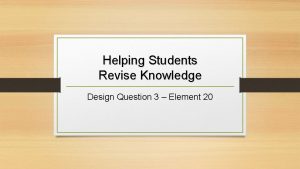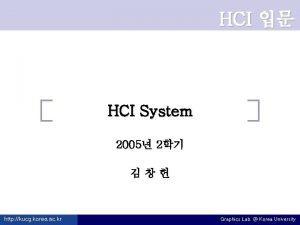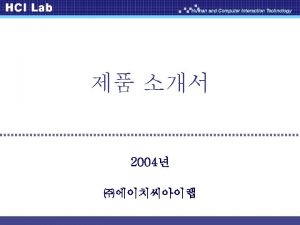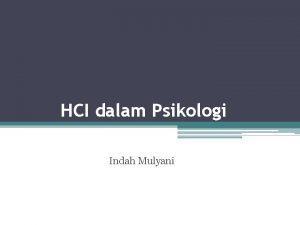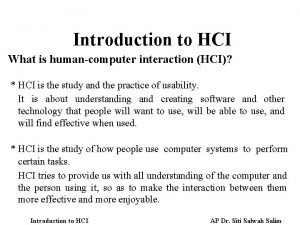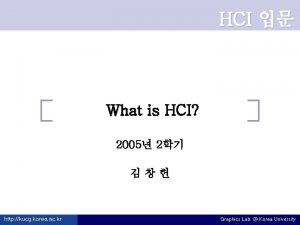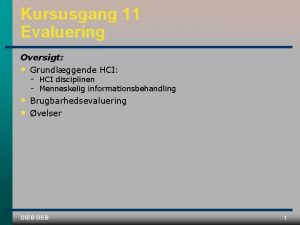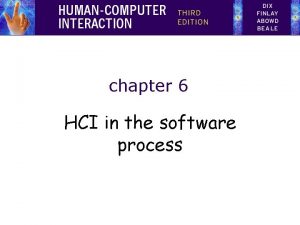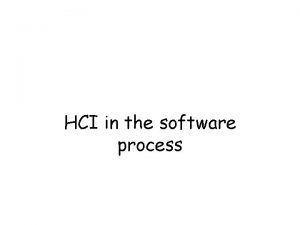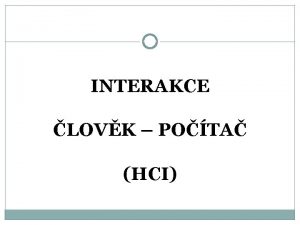Challenging students to acquire deeper knowledge in HCI



























- Slides: 27

Challenging students to acquire deeper knowledge in HCI course N. Ackovska and M. Kostoska 15 th Workshop on “Software Engineering and Reverse Engineering” Bohinj, 23 -30 September 2015

Outline Human Computer Interaction Course Topics Course Grading System Inquiry-Based Approach Evaluation Methodology Results Conclusion

Human Computer Interaction Course Around 600 students in the past six years Main objective: • Understand FEEL the basics of the complex interaction between the computer and the user • Acquire knowledge that many users have different application usage skills, knowledge and opportunities Syllabus covers relevant topics recognized by the ACM/IEEE recommendations

Human Computer Interaction Course Elective course (third or fourth year of studies) Organization: Theoretical lectures with 2 classes per week Lecture exercises with 1 class per week Practical lab tutorials with 2 classes per week The course has weight of 6 ECTS

The Course Grading Scheme Activity Total activity points Min. required points Laboratory exercises (5 individual exercises) 30 15 40 20 30 -50 15 Theory exams (2 midterm exams or 1 final exam) Project

Outline Human Computer Interaction Course Topics Course Grading System Inquiry-Based Approach Evaluation Methodology Results Conclusion

Inquiry-Based Learning From Wikipedia, the free encyclopedia Inquiry-based learning starts by posing questions, problems or scenarios—rather than simply presenting established facts or portraying a smooth path to knowledge. The process is often assisted by a facilitator. Inquirers will identify and research issues and questions to develop their knowledge or solutions.

Inquiry-Based Approach The students are proposing challenging projects Receive approval or comments regarding the proposed project Team projects are encouraged, but individual work is allowed as well Students discover the challenges and raise questions regarding specific technologies , principles or methodologies they are supposed to use and try to discover solution

Inquiry-Based Approach At all times students are offered facilitation IT technologies Specific target group Meetings – weekly basis (during practical lab tutorials) Every team or individual has different learning curve However, every project should go through certain milestones

Project Milestones

Outline Human Computer Interaction Course Topics Course Grading System Inquiry-Based Approach Evaluation Methodology Results Conclusion

Evaluation Methodology Perspective 1: Individual vs Team work • average number of students per team Perspective 2: Target group with limitations vs Target group with no limitations • whether the students will challenge themselves for people with disabilities or some kind of cognitive, mental or physical limitations

Evaluation Methodology Perspective 3: Use practical knowledge from previous courses only vs Learn new technologies or apply formal knowledge Usage of acquired skills and practical knowledge only from previous courses New technology concepts Apply formal theoretical knowledge from previous courses

Outline Human Computer Interaction Course Topics Course Grading System Inquiry-Based Approach Evaluation Methodology Results Conclusion

Results – Perspective 1 Year Num. projects Num. students 2008 28 112 2009 26 95 2010 46 141 2011 55 122 2012 19 56 2013 21 The subject is fully elective 50

Results – Perspective 1 Team sizes per project 100 50 0 Individual 2 members 3 members 4 members 5 members Students mostly choose to work in teams with 2 and 3 members

Perspective 2 – Create for different? How interesting are software / hardware systems that apply real limitations in • Input / output devices • Content has to be limited / made easier / adapted • The view has to be adapted • The environment is limited, known in advance • …

Target groups are interesting for students! Applications for users with great limitations: • people with limited motoric functions • blind or people with limited sight, • deaf and hard of hearing etc. Also larger groups with specifics: • kids • elderly people • Social groups – music, sports, travel, pets… • …. . • which require specific and limiting interface design as well

Results – Perspective 2 40 out of 195 projects in total are targeted for people with disabilities or some type of interaction limitation Projects for Specific Target Groups Projects for Standard Users

Results – Perspective 2 Percentage of Projects for Specific Target Groups 45% 40% 35% 30% 25% 20% 15% 10% 5% 0% 2008 2009 2010 2011 2012 2013

Perspective 3 – Learn more? Technology (examples) • Learn XNA technology • Learn Objective C and i. OS SDK • Use Google Sketch Up, Use Unity 3 D • … Theory (examples) • Use mathematical knowledge about vectors, matrices and their transformation to create custom animation importer and games • Use A* algorithm • Use probability and randomness algorithms • … • Use patterns – mobile, cloud implementation…

Results – Perspective 3 Acquiring new technological concepts or technologies 22% 7% 71% Acquiring or using formal theoretical knowledge Usage of previous knowledge only

Results – Perspective 3 Knowledge acquisition per years 90% 80% 70% 60% 50% 40% 30% 20% 10% 0% 2008 2009 2010 2011 2012 New technological concepts or technologies Acquiring or using formal theoretical knowledge Usage of previous knowledge only 2013

Outline Human Computer Interaction Course Topics Course Grading System Inquiry-Based Approach Evaluation Methodology Results Conclusion

Conclusion The students conducted many researches and were constantly encouraged to ask questions, to find answers and to improve their projects Facilitating the IB learning, the students tend to work in smaller groups

Conclusion Around 30% of the students were interested to extend their knowledge or apply formal knowledge Great aspect of the course - it raises the awareness of the students about the people with disabilities, age-aware design, even with different culture values

Thank you! Questions please
 Into the heart of jesus deeper and deeper i go
Into the heart of jesus deeper and deeper i go Acquiring spiritual knowledge
Acquiring spiritual knowledge Dealing with challenging patients
Dealing with challenging patients Challenging behaviour scenarios
Challenging behaviour scenarios Children challenging industry
Children challenging industry What i found challenging
What i found challenging Feasibility study in sdlc
Feasibility study in sdlc Challenging text examples
Challenging text examples Periodic sentence literary definition
Periodic sentence literary definition Abc worksheets cpt
Abc worksheets cpt Exciting, boring, dangerous, safe, interesting, challenging
Exciting, boring, dangerous, safe, interesting, challenging The most creative and challenging phase of sdlc is
The most creative and challenging phase of sdlc is Challenging resistance to change
Challenging resistance to change Zfinancial
Zfinancial Rizal and his party went to pagsanjan for what reason?
Rizal and his party went to pagsanjan for what reason? Advapi
Advapi Acquire project team
Acquire project team Acquire collocation
Acquire collocation How did jay gould make his money
How did jay gould make his money Utilize knowledge
Utilize knowledge Acquire resources
Acquire resources What is modulation
What is modulation Difference merger and acquisition
Difference merger and acquisition Pre assignment
Pre assignment How do humans acquire language
How do humans acquire language Organizing students to practice and deepen knowledge
Organizing students to practice and deepen knowledge Marzano element 15
Marzano element 15 Helping students revise knowledge
Helping students revise knowledge


